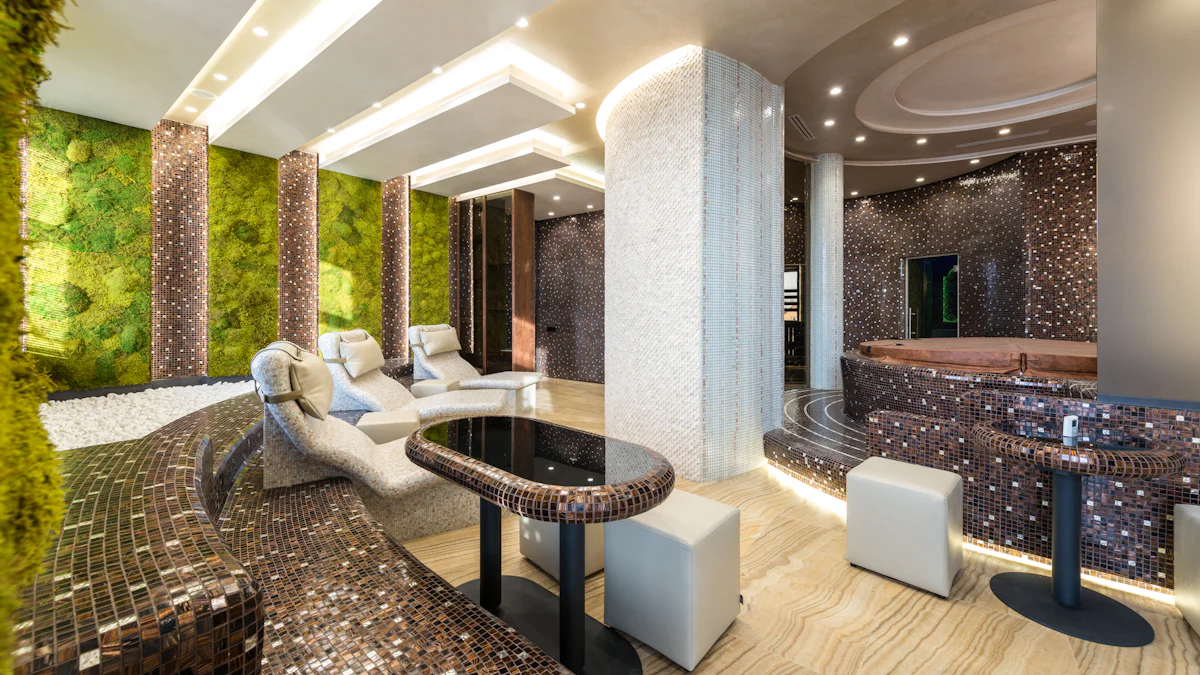how to open up a beauty spa business

The beauty spa industry has experienced remarkable growth, with the U.S. market reaching $18.1 billion in 2021. This surge highlights the increasing demand for wellness and relaxation services. Starting a beauty spa business offers numerous benefits, including the potential for high revenue and the opportunity to create a serene environment for clients. A well-managed spa can attract a loyal customer base, ensuring steady bookings for spa appointments. This guide will provide essential steps to help you succeed in the massage and spa business.
Creating a Business Plan
Market Research
Identifying Target Audience
Understanding the target audience forms the foundation of a successful beauty spa business. Identify the specific demographic that will benefit from the services offered. Consider factors such as age, gender, income level, and lifestyle preferences. For example, a luxury spa may attract high-income professionals seeking premium services. Conduct surveys and gather data to gain insights into the needs and preferences of potential clients. This information will guide decisions on service offerings and marketing strategies.
Analyzing Competitors
Analyzing competitors provides valuable insights into the market landscape. Identify local spas and study their service menus, pricing, and customer reviews. Determine what sets them apart and identify gaps in their offerings. Use this information to create a unique value proposition for the beauty spa business. Offering exclusive treatments or exceptional customer service can differentiate the spa from competitors. Regularly monitor competitors to stay updated on industry trends and adjust strategies accordingly.
Defining Your Services
Core Services
Define the core services that will form the backbone of the beauty spa business. Common core services include massages, facials, and body treatments. Ensure these services meet high standards of quality and professionalism. Invest in skilled therapists and high-quality products to deliver exceptional experiences. Consistency in core services builds a loyal customer base and encourages repeat spa appointments.
Additional Offerings
Expand the service menu with additional offerings to attract a wider audience. Consider services such as manicures, pedicures, and hair removal treatments. Offering packages and memberships can also enhance customer retention. Seasonal promotions and special events can generate interest and boost bookings. Tailor additional offerings to the preferences of the target audience to maximize appeal.
Financial Projections
Startup Costs
Calculate the startup costs required to launch the beauty spa business. Include expenses such as leasing or purchasing a location, renovating the space, and purchasing equipment. Factor in costs for licensing, permits, and insurance. Budget for marketing and initial inventory of products. A detailed list of startup costs helps secure financing and ensures a smooth launch.
Revenue Forecasting
Project the revenue potential of the beauty spa business. Estimate the number of clients and average spending per visit. Consider factors such as seasonality and local demand. Use this data to forecast monthly and annual revenue. Regularly review and adjust projections based on actual performance. Accurate revenue forecasting helps manage cash flow and plan for growth.
Selecting a Location

Choosing the right location for a beauty spa business plays a crucial role in its success. The location impacts client accessibility and overall business visibility. Consider several factors to ensure the selected spot aligns with the business goals.
Factors to Consider
Demographics
Understanding the local demographics helps tailor the services to meet the community's needs. Research the age, income level, and lifestyle of the area's residents. A high-income neighborhood might prefer luxury treatments, while a younger demographic might seek trendy and affordable services. Aligning the spa services with the local population ensures a steady flow of clients and frequent spa appointments.
Accessibility
Accessibility significantly influences client satisfaction and repeat visits. Choose a location with ample parking and convenient public transportation options. Ensure the spa is easily reachable for both clients and staff. High foot traffic areas, such as shopping centers or busy streets, can enhance visibility and attract walk-in clients. Prioritize locations that offer ease of access to maximize client convenience.
Leasing vs. Buying
Deciding between leasing and buying a property involves weighing the pros and cons of each option. Both choices have implications on the financial and operational aspects of the beauty spa business.
Pros and Cons of Leasing
Leasing offers flexibility and lower initial costs. Lease agreements typically involve less liability and allow for starting small. This option minimizes risks and provides an opportunity to test the market without a significant financial commitment. However, leasing may come with restrictions on property modifications and potential rent increases over time.
Pros and Cons of Buying
Buying a property requires a substantial investment but offers long-term benefits. Ownership provides full control over the space, allowing for extensive customization to create the desired ambiance. Property ownership can also appreciate in value, adding to the business's assets. On the downside, buying involves higher upfront costs and ongoing maintenance responsibilities. Weigh these factors carefully to determine the best option for the massage and spa business.
Financing Your Spa
Funding Options
Personal Savings
Using personal savings to finance a beauty spa business offers several advantages. Personal savings eliminate the need for loan repayments and interest. This option provides full control over finances. Consider the amount of savings available and ensure it covers startup costs. Using personal savings requires careful budgeting to avoid financial strain.
Business Loans
Business loans provide another viable funding option. Many financial institutions offer loans tailored for small businesses. Research different lenders and compare interest rates and terms. Prepare a solid business plan to present to lenders. A well-prepared plan increases the chances of loan approval. Consider the repayment schedule and ensure the business can generate enough revenue to meet obligations.
Investors
Securing investors can provide significant capital for the massage and spa business. Investors may include family, friends, or professional venture capitalists. Present a compelling case to potential investors. Highlight the unique value proposition and growth potential of the business. Investors often seek a return on investment, so outline how the business plans to achieve profitability. Establish clear terms and agreements to maintain a positive relationship with investors.
Budgeting
Initial Investments
Initial investments cover the costs required to launch the beauty spa business. These costs include leasing or purchasing a location, renovations, and equipment purchases. Allocate funds for licensing, permits, and insurance. Marketing expenses also form a part of initial investments. Create a detailed budget to track all expenses. Proper budgeting ensures that the business starts on a solid financial footing.
Ongoing Expenses
Ongoing expenses include operational costs that the business will incur regularly. These expenses cover salaries for staff, utility bills, and inventory replenishment. Regular maintenance of equipment and facilities also forms part of ongoing expenses. Allocate a portion of the budget for marketing efforts to attract new clients and retain existing ones. Monitor ongoing expenses closely to ensure the business remains profitable. Adjust the budget as needed to reflect changes in the business environment.
Designing the User Experience

Interior Design
Ambiance and Aesthetics
Creating a serene ambiance and appealing aesthetics is essential for a beauty spa. Use soothing color schemes to promote relaxation. Incorporate natural elements such as plants and water features. Strategically place decor to enhance the overall atmosphere. Engage all senses by using calming scents and soft background music. Ensure that every element contributes to a tranquil environment.
Functional Layout
A functional layout ensures smooth operations and enhances client comfort. Design treatment rooms with adequate space for therapists to move freely. Position reception and waiting areas to provide privacy and comfort. Use ergonomic furniture to support both clients and staff. Ensure that storage areas are easily accessible yet discreet. A well-planned layout improves efficiency and client satisfaction.
Customer Service
Staff Training
Exceptional customer service begins with thorough staff training. Train employees on the importance of clear communication and active listening. Emphasize the need for personalized services to make each client feel valued. Equip staff with the skills to handle various client needs and preferences. Regular training sessions ensure that the team stays updated on industry standards and best practices.
Client Interaction
Positive client interaction fosters loyalty and repeat visits. Greet clients warmly upon arrival and offer refreshments. Maintain a friendly and professional demeanor throughout the visit. Address clients by name to create a personal connection. Follow up after appointments to gather feedback and show appreciation. Consistent, high-quality interactions enhance the overall client experience and contribute to business growth.
Marketing Your Spa
Branding
Creating a Brand Identity
Creating a strong brand identity sets the foundation for your beauty spa's success. A well-defined brand communicates your spa's values and mission to clients. Start by identifying the unique qualities that differentiate your spa from competitors. Use these qualities to craft a compelling brand story. Consistency in messaging across all platforms reinforces your brand identity. Ensure that every touchpoint, from the website to in-spa materials, reflects your brand's essence.
Logo and Visuals
A memorable logo serves as the visual cornerstone of your brand. Invest in professional design services to create a logo that embodies your spa's identity. Use colors and fonts that align with the ambiance of your spa. Incorporate the logo into all marketing materials, including business cards, brochures, and social media profiles. High-quality visuals enhance brand recognition and leave a lasting impression on clients.
Online Presence
Website Development
An effective website acts as the digital front door of your beauty spa. Ensure the website is user-friendly and visually appealing. Include essential information such as services, pricing, and contact details. Use high-quality images to showcase the spa's ambiance and treatments. Implement an online booking system to streamline appointment scheduling. Optimize the website for search engines to increase visibility. Regularly update content to keep clients informed about new services and promotions.
Social Media Marketing
Social media platforms offer powerful tools for engaging with potential clients. Create profiles on popular platforms like Instagram, Facebook, and Twitter. Share visually appealing content that highlights your spa's services and atmosphere. Use stories and live videos to give followers a behind-the-scenes look. Encourage satisfied clients to share their experiences and tag your spa. Positive reviews and testimonials build credibility and attract new clients. Monitor engagement and respond promptly to comments and messages.
Local Marketing
Community Engagement
Active community engagement fosters strong local connections. Participate in local events and sponsor community activities. Offer free workshops or wellness seminars to showcase your expertise. Collaborate with local businesses to cross-promote services. Building relationships within the community enhances your spa's reputation and attracts loyal clients. Word-of-mouth referrals from community members can significantly boost your client base.
Partnerships and Collaborations
Forming partnerships with complementary businesses expands your reach. Collaborate with local gyms, hotels, and salons to offer joint promotions. Create exclusive packages that combine services from both businesses. Partner with wellness influencers to promote your spa on social media. These collaborations introduce your spa to new audiences and drive traffic. Establish clear terms and mutual benefits to ensure successful partnerships.
Starting a beauty spa business involves several key steps. Create a solid business plan, select an ideal location, secure financing, and design an exceptional user experience. Effective marketing will attract and retain clients.
Opening a spa requires dedication and careful planning. Personalize services to meet client needs and create memorable experiences. This approach will set your spa apart from competitors.
Aspiring spa owners should take the first step today. Begin the journey toward creating a successful beauty spa business.
See Also
Boost Your Service Business Growth with ChatGPT Strategies
Effective Salon Appointment Cancellation Policies for 2024
Crafting a Tailored ChatGPT Chatbot for Business Success
Mastering the Art of Politely Requesting Upfront Payments
Transforming Walk-in Appointments with Custom ChatGPT Scheduling

